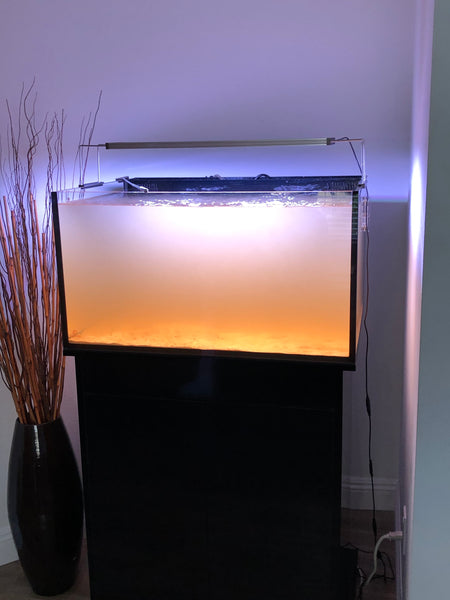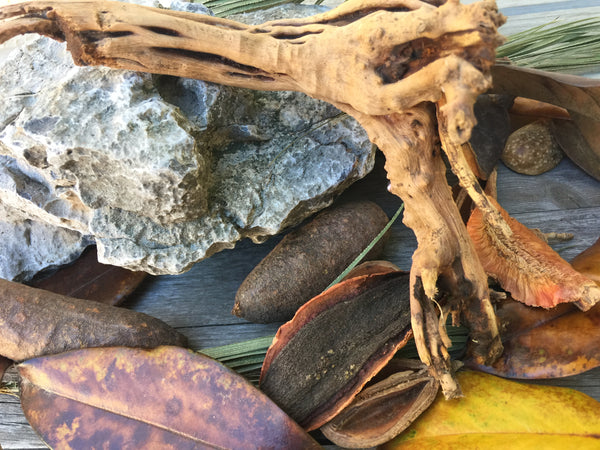- Continue Shopping
- Your Cart is Empty
The "startup" phase and its natural analogies...
It's largely for "business purposes", but it seems like I've set up more aquairums in the past year than I have in the previous 2-3 years. Seems like every month I have something new going up- or about to!

And of course, being a fish geek- even when its for "business" purposes (ie; sharing some new and inspirational ideas)- it's still incredibly fun and educational. I get new insights about aquariums- and the natural habitats which inspire them- every time I set one up!
When you think about it sort of analytically, one of the neat things about setting up a new aquarium is that, like it or not- you go through the time-honored traditions of stuff as mundane as washing sand, setting in heaters and lights, cleaning and preparing wood and other hardscape materials, etc. You can't escape most of those tasks.
Nor should you want to.
I mean, unless you're using "live" material from an existing tank or pond, you pretty much have to rinse sand...whatever technique you use, it's almost unavoidable. And that often creates lingering cloudiness that simply takes a bit of waiting to resolve. And then there is what I like to call "the settling period", also jokingly referred to by us patient types as the "calm before the storm"- that period of a few days when you let everything sort of "sit" for a bit- allowing the water to clear, any bubbles to be mitigated, etc.
I actually love this period of time, because it's the last point in my tank's existence that it's "sterile"- before we begin preparing the "biological" part of the system.

You know, getting the wood and stones positioned right, making sure that the basic water parameters (alkalinity, pH, TDS, etc.) are where you want them before you start "seeding" the system with bacteria, or whatever your technique is to make your tank "come alive." This is an exciting time-a time to really make sure that things are running how you'd like them, to assure yourself that the basic hardscape is positioned how you think it should be, and that the system is "mechanically" running reliably.
It's a very exciting time. And, when viewed with the correct mindset, it's as gratifying, fascinating, and enjoyable as any other period of time in the life of your tank.

I recently considered all of these thoughts as I went through this period right now in my new home blackwater aquarium, and it's a very "contemplative" time, too- if you make it that way...and of course, I always tend to, lol.
I find myself viewing this time as a real chance to "get things right"- that time to deploy a lot of patience and ask myself those honest questions, like, "Is this EXACTY how you want those pieces of wood positioned?" or ,"Do you want to use those rocks in those positions?" OR, "Do I even WANT to use rocks..?" Like, I hate "editing" my hardscape as I go, so to me, once I start "going biological" with a tank, the "honeymoon" is over...
Those pieces of wood and rock are staying in those exact positions until either I knock them out of position during maintenance (that never happens, right?) or I break down the tank. Yeah, I'm pretty hardcore about it!

Of course, it's also a time when I tell myself, "Okay Fellman- no turning back..." Sort of like when an airplane is committed to "rotate" for takeoff...I guess I commit to a hardscape like I run my business: Conceive. Tweak. Execute. Manage (insert- "fix disasters..." here, lol). I think that it's a lot like how Nature works...Well, sort of?
Once a tree falls, it typically moves very little, unless water movement or subsidence from the substrate alters how it's settled. And "stuff" (leaves, twigs, seed pods, etc.) accumulates around it, further "cementing" its position in the habitat.
Yes, I have a weird way of looking at stuff.

And I suppose that it's correct to acknowledge that, despite my labeling this period of time as a "sterile" period, it's really the first step of creating a "biologically active" system. I mean, wood contains all sorts of "stuff", including organic materials and probably even good old fashioned terrestrial "dirt", which fuels the growth of bacteria...despite our best efforts at "cleaning" or otherwise "preparing" it for aquarium use.
And the tannins which wood often gives off once submerged?
I mean, that's like nature's little "gift" for the "tinter!"

While the rest of the aquarium world pouts, agonizes, and generally freaks the f--- out about "the tannins 'discoloring' my water"- we see this as one of the rare "hacks"- a gift from Mother Nature to help us speed up the process of getting that visual "tint" to our water that we love so much!
Don't believe me about how the rest of the hobby reacts to this? Search like any aquatic hobby forum and look at the frantic posts from hobbyists looking for anything to help remove this dreaded "scourge" of tint from their aquariums. I know, I shouldn't be so callous and unsympathetic to their "plight"- but if these heathens only knew what they were missing...
I mean, I get frantic emails from customers wondering how to make their tanks darker!
Shit, this is weird, huh?
So, yeah. We take our victories where we can get them, right?
Let's talk about that "biological phase", as I call it- just for s second...
Pretty much anything that we add to the aquarium contains some biological material (ie. bacteria, fungal or algal spores, etc.), right? And when they hit the water, it begins a process of growth, colonization, and proliferation that won't stop. These processes are so beneficial and important to our systems...
When we have these materials in place, the "microfaunal ecosystem" begins to "ignite" and grow. We often talk about the large influx of "nutrients" present in a new aquarium, and "immature" nutrient export systems in place to handle it. I mean, the tank plays a sort of biological "catch up" during this time, as the bacterial and fungal growths proliferate among the abundant nutrients. We might rely a bit more on mechanical and chemical filtration during this period. However, ultimately, these natural "nutrient export mechanisms" will take over.

It just takes time.
And a mindset where you're not totally obsessed with removing every bit of "dirt" or material which looks offensive. Allowing the the nitrogen cycle to really establish itself, and natural processes develop, will really "set the tone" for our botanical-style aquariums, IMHO. We shouldn't let some of the initial visual clues, like "cloudiness", biofilms, etc. compel us to whip out the siphon hose and remove every bit of the "offensive"-looking material from our tanks. Otherwise, we end up working agains the very processes that we're trying to foster in a botanical-style aquarium!

It takes patience, understanding, observation- and a vision.
And we're patient. And determined. And we understand that a botanical-style aquarium truly must "evolve" and take time to begin to blossom into a functioning little ecosystem. And we enjoy each and every stage of the "startup" process for what it is: An analog to the processes which occur in the natural habitats we want so badly to emulate. I think one of the mental "games" I've always played with myself during this process is to draw parallels between what I'm doing to prepare my tank and what happens in nature.

It kind of goes something like this:
A tree falls in the (dry) forest (Really, Fellman's riffing about trees AGAIN? Well, yeah...). Wind and gravity determine its initial resting place (you play around with positioning your wood pieces until you get 'em where you want, and in a position that holds!). A little rain falls (we spray down our hardscapes...), moistening the dry materials that abound in the substrate.
Next, other materials, such as leaves and perhaps a few rocks become entrapped around the fallen tree or its branches (we set a few "anchor" pieces of hardscaping material into the tank). Detritus settles (you know, that damn "sediment" that you get in newly setup tanks...) Then, the heavier rain comes; streams overflow, and the once-dry forest floor becomes inundated (we fill the aquarium with water).

The action of water and rain help "set" the final position of the tree/branches, and wash more materials into the area influenced by the tree (we place more pieces of botanicals, rocks, leaves, etc. into place). The area settles a bit, with occasional influxes of new water from the initial rainfall (we make water chemistry tweaks and maybe a top-off or two, as needed).
Fungi, bacteria, and insects begin to act upon the wood and botanicals which have collected in the water (kind of like what happens in our tanks, huh? Yes- biofilms are beautiful...). Gradually, the first fishes begin to follow the food and populate the area (we add our first fish selections based on our stocking plan...). It continues from there. Get the picture? Sure, I could go on and on attempting to painfully draw parallels to every little nuance of tank startup, but I think you know where I'm going with this stuff...

And the thing we must deploy at all times in this process is patience.
And an appreciation for each and every step in the process, and how it will influence the overall "tempo" and ultimate success of the aquarium we are creating. When we take the view that we are not just creating an "aquatic display", but a habitat for a variety of aquatic life forms, we tend to look at it as much more of an evolving process than a step-by-step "procedure" for getting somewhere.
Do some reading on the "bioactive" processes our frog and herp friends strive to create in their beautiful vivariums and enclosures- there are many analogous and educational takeaways there!

Creating such a habitat, and fostering stuff like the development of a basic kind of "food web" is really an amazing process and is filled with potential breakthroughs for aquariums. And I think that, even if we don't consider the concept, we as hobbyists sort of have been helping develop some aspects of these "food webs" for some time now in almost every type of aquarium that we've set up...
An interesting thing to contemplate, right?

Taking the time to consider, study, and savor each phase is such an amazing thing, and I'd like to think that, as students of this most compelling aquarium hobby niche, that we can appreciate the evolution as much as the "finished product" (if there ever is such a thing in the aquarium world).

It all starts with an idea...and a little bit of a "waiting game..." and a belief in Nature; a trust in allowing the natural processes which have guided our planet and its life forms for eons to develop to the extent that they can in our aquariums.
The appreciation of this process is a victory in and of itself, isn't it?
I think it is.
And the "startup phase" of our aquariums is the key component to fostering the process. Enjoy it. Understand it. Appreciate it for what it really is...A beginning of a closed ecological system.
Stay motivated. Stay excited. Stay obsessed. Stay observant. Stay appreciative...Stay patient...
And Stay Wet.
Scott Fellman
Tannin Aquatics








Scott Fellman
Author